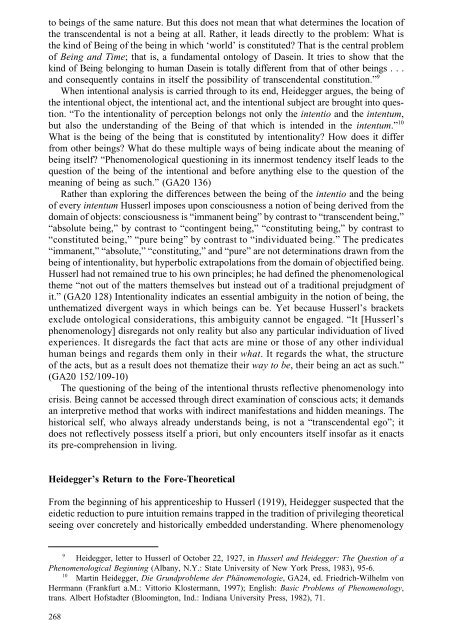[Andrzej_Wiercinski_(ed ... - WordPress.com
[Andrzej_Wiercinski_(ed ... - WordPress.com
[Andrzej_Wiercinski_(ed ... - WordPress.com
You also want an ePaper? Increase the reach of your titles
YUMPU automatically turns print PDFs into web optimized ePapers that Google loves.
to beings of the same nature. But this does not mean that what determines the location ofthe transcendental is not a being at all. Rather, it leads directly to the problem: What isthe kind of Being of the being in which ‘world’ is constitut<strong>ed</strong>? That is the central problemof Being and Time; that is, a fundamental ontology of Dasein. It tries to show that thekind of Being belonging to human Dasein is totally different from that of other beings . . .and consequently contains in itself the possibility of transcendental constitution.” 9When intentional analysis is carri<strong>ed</strong> through to its end, Heidegger argues, the being ofthe intentional object, the intentional act, and the intentional subject are brought into question.“To the intentionality of perception belongs not only the intentio and the intentum,but also the understanding of the Being of that which is intend<strong>ed</strong> in the intentum.” 10What is the being of the being that is constitut<strong>ed</strong> by intentionality? How does it differfrom other beings? What do these multiple ways of being indicate about the meaning ofbeing itself? “Phenomenological questioning in its innermost tendency itself leads to thequestion of the being of the intentional and before anything else to the question of themeaning of being as such.” (GA20 136)Rather than exploring the differences between the being of the intentio and the beingof every intentum Husserl imposes upon consciousness a notion of being deriv<strong>ed</strong> from th<strong>ed</strong>omain of objects: consciousness is “immanent being” by contrast to “transcendent being,”“absolute being,” by contrast to “contingent being,” “constituting being,” by contrast to“constitut<strong>ed</strong> being,” “pure being” by contrast to “individuat<strong>ed</strong> being.” The pr<strong>ed</strong>icates“immanent,” “absolute,” “constituting,” and “pure” are not determinations drawn from thebeing of intentionality, but hyperbolic extrapolations from the domain of objectifi<strong>ed</strong> being.Husserl had not remain<strong>ed</strong> true to his own principles; he had defin<strong>ed</strong> the phenomenologicaltheme “not out of the matters themselves but instead out of a traditional prejudgment ofit.” (GA20 128) Intentionality indicates an essential ambiguity in the notion of being, theunthematiz<strong>ed</strong> divergent ways in which beings can be. Yet because Husserl’s bracketsexclude ontological considerations, this ambiguity cannot be engag<strong>ed</strong>. “It [Husserl’sphenomenology] disregards not only reality but also any particular individuation of liv<strong>ed</strong>experiences. It disregards the fact that acts are mine or those of any other individualhuman beings and regards them only in their what. It regards the what, the structureof the acts, but as a result does not thematize their way to be, their being an act as such.”(GA20 152/109-10)The questioning of the being of the intentional thrusts reflective phenomenology intocrisis. Being cannot be access<strong>ed</strong> through direct examination of conscious acts; it demandsan interpretive method that works with indirect manifestations and hidden meanings. Thehistorical self, who always already understands being, is not a “transcendental ego”; itdoes not reflectively possess itself a priori, but only encounters itself insofar as it enactsits pre-<strong>com</strong>prehension in living.Heidegger’s Return to the Fore-TheoreticalFrom the beginning of his apprenticeship to Husserl (1919), Heidegger suspect<strong>ed</strong> that theeidetic r<strong>ed</strong>uction to pure intuition remains trapp<strong>ed</strong> in the tradition of privileging theoreticalseeing over concretely and historically emb<strong>ed</strong>d<strong>ed</strong> understanding. Where phenomenology9Heidegger, letter to Husserl of October 22, 1927, in Husserl and Heidegger: The Question of aPhenomenological Beginning (Albany, N.Y.: State University of New York Press, 1983), 95-6.10Martin Heidegger, Die Grundprobleme der Phänomenologie, GA24, <strong>ed</strong>. Fri<strong>ed</strong>rich-Wilhelm vonHerrmann (Frankfurt a.M.: Vittorio Klostermann, 1997); English: Basic Problems of Phenomenology,trans. Albert Hofstadter (Bloomington, Ind.: Indiana University Press, 1982), 71.268


